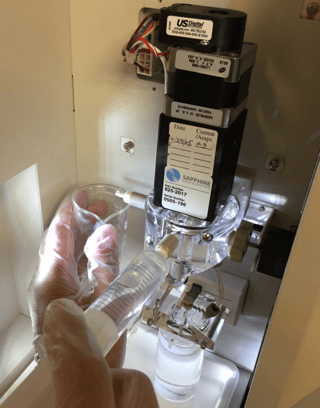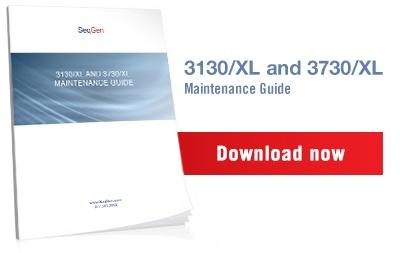
We all know that our sequencers need constant maintenance and attention to stay at the top of their game, but keeping up with each and every tiny moving part on these machines can seem daunting.
One of the little parts on the ABI 3130/xl, 3730/xl, 3500/xl to stay on top of is the piston. If you neglect to take care of this piston, the polymer can back-flow into the pump motor, which can cause serious problems (and an expensive service visit) down the road. Flushing the water trap is the easiest way to care for it. So to make sure your traps and pistons are squeaky-clean, follow these six easy steps to flush the trap on your ABI sequencers.
Flushing your Water Trap
Before you start this procedure, make sure the pump is not in action. Performing this procedure while the pump is in action can cause additional damage.
Step 1:
Fill a 20mL Luer fitting syringe with distilled water. You can use a larger syringe if you have to, but using anything smaller than a 20mL may generate excessive pressure within the trap causing further damage. Make sure to get all of the bubbles out of the syringe before you start the procedure.
Step 2:
Turn the top-front fitting counter-clockwise to loosen it. You don’t want to remove the fitting, just loosen it enough to attach the syringe to the fitting.
For 3130/xl and 3730/xl: please also turn the exit fitting loose on the top-left
Step 3:
Attach the syringe to the fitting. You’ll probably have to hold the fitting steady while you thread the syringe into it. Then, slowly start injecting the water into the pump.
If you’re working on a 3130/xl or 3730/xl, you’ll need to hold a beaker under the exit fitting in order to catch the wastewater, as shown in the picture below.

Step 4:
The wastewater will be dispensed into the waste bottle. You may notice some bubbles in the channel as you’re completing this step, but this is normal and they won’t affect the function of the pump.
Step 5:
After all of the water has been dispensed into the waste bottle or beaker, remove the syringe and re-tighten the fittings by turning it clockwise. Make sure not to over-tighten the fittings or they could be damaged. They only need to be tight enough to prevent water leaks.
Step 6:
Now you can remove the waste bottle from the instrument and clean it. Your water trap should be completely flushed and clear of any dried or degraded polymer.
Our service technicians recommend that you flush the traps on your ABI sequencers at least once a month to prolong the life of your pumps. By taking care of your machine and the various parts in it, you can eliminate unexpected machine downtime, reduce unnecessary wear on your instruments and guarantee high-quality data. If you run into any issues along the way, make sure to let us know, and we’ll walk you through any problem you encounter.


